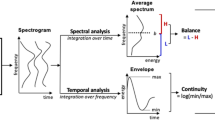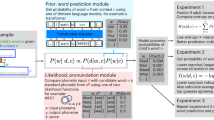Abstract
BLOOMFIELD1 has rejected the hypothesis that in a dichotic listening situation the selection of the attended message by the subject is based only on spatial cues, and argued that the transition probabilities between words also affects their selection. Physical cues rather than spatial ones should have been referred to because it has been demonstrated that selection can be made in the absence of spatial cues if the two messages are presented in distinctly different voices2. Only the variety of the rejected hypothesis which also postulates simultaneous analysis of the unattended message is considered in the theoretical treatment of results. If attenuation of the secondary channel and selection on the basis of physical cues only are postulated3, then words presented in the secondary channel have a reletively high recognition threshold. Without contextual information potentially gained from previous words, the instruction “tap” does not have a lowered threshold and we would not expect it to be heard. Our hypothesis contradicts Bloomfield's conclusion, although it is compatible with his data. Also in the presence of unequivocal physical separation (messages presented to different ears in different voices3) listeners never reported items from the secondary message. A strong stimulus set overrides even a strong response set4. Changing the contextual probability within a message is not “known to result in switching to the alternative channel”, as Bloomfield asserts; Treisman3 has reported that “subjects occasionally repeated one or two words” from the secondary message when those words were more appropriate than those presented simultaneously in the primary message. Recognition of a word presented in the secondary message is only likely when that word is appropriate to the selected message. Presentation of an improbable word in the selected message may lower the recognition thresholds for more probable words presented in other messages, but this does not necessarily affect the threshold for other contextually improbable instructions such as “tap”. Giving the listener a response set towards this word might reduce this threshold.
This is a preview of subscription content, access via your institution
Access options
Subscribe to this journal
Receive 51 print issues and online access
$199.00 per year
only $3.90 per issue
Buy this article
- Purchase on Springer Link
- Instant access to full article PDF
Prices may be subject to local taxes which are calculated during checkout
Similar content being viewed by others
References
Bloomfield, T. M., Nature, 236, 465 (1972).
Treisman, A. M., Amer. J. Psychol., 77, 206 (1964).
Treisman, A. M., Quart. J. Exp. Psychol., 12, 242 (1960).
Broadbent, D. E., in Attention: Contemporary Theory Analysis, 51 (Appleton-Century-Crofts, New York, 1970).
Howes, D. H., and Soloman, R. L., J. Exp. Psychol., 41, 401 (1951).
Bruce, D. J., in Information Theory, 245 (Butterworth, London, 1956).
Soloman, R. L., and Postman, L., J. Exp. Psychol., 43, 195 (1952).
Savin, H. B., J. Acoust. Soc. Amer., 35, 200 (1963).
Broadbent, D. E., Psychol. Rev., 74, 1 (1967).
Moray, N., Acta Psychol., 27, 84 (1967).
Author information
Authors and Affiliations
Rights and permissions
About this article
Cite this article
UNDERWOOD, G. Transition Probability and Dichotic Listening. Nature 241, 134–135 (1973). https://doi.org/10.1038/241134a0
Received:
Issue Date:
DOI: https://doi.org/10.1038/241134a0
Comments
By submitting a comment you agree to abide by our Terms and Community Guidelines. If you find something abusive or that does not comply with our terms or guidelines please flag it as inappropriate.



